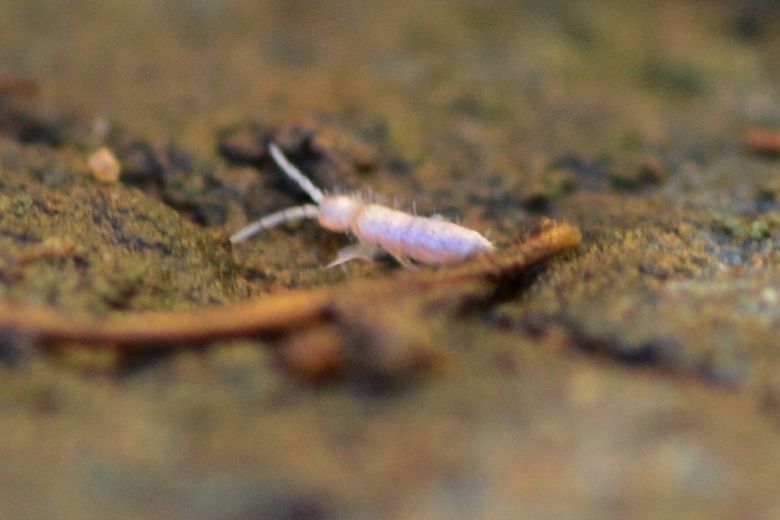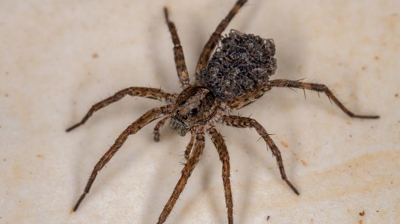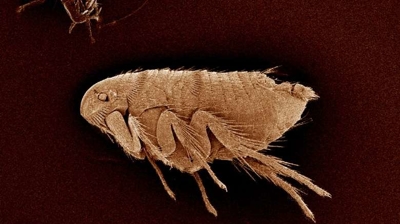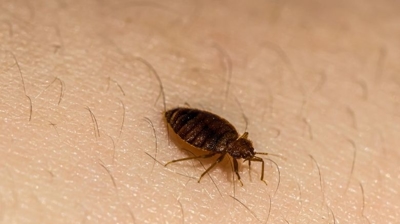
Springtails

Are Springtails Harmful?
Springtails are generally not considered harmful to humans and are more often seen as beneficial. However, there are some circumstances in which they can pose minor challenges or concerns:
- Indoor Nuisance: Springtails can sometimes find their way indoors, especially in damp or moist areas of homes. While they don't pose direct health risks, their presence indoors may be considered a nuisance. They can gather in large numbers in basements, bathrooms, and other areas with high humidity.
- Contamination of Stored Products: Springtails can potentially infest stored products like grains or foodstuffs if the conditions are humid. While they don't directly harm the food, their presence may be considered undesirable in certain situations.
- Allergies: In some instances, individuals with allergies or sensitivities to arthropods may experience mild allergic reactions or skin irritation if they come into contact with springtails. However, such reactions are relatively rare.
- Asthma Triggers: In very rare cases, the presence of springtails, or more precisely, their fecal matter, could trigger asthma symptoms in individuals with severe allergies or asthma. This is highly uncommon and generally only occurs in specific circumstances.
The potential issues associated with springtails are relatively minor compared to the numerous benefits they provide in ecosystems, particularly their roles in decomposition, nutrient cycling, and soil health. Most of the concerns related to springtails can be addressed through preventive measures, such as controlling moisture levels indoors or implementing integrated pest management strategies in agriculture.
Learn more: Do Springtails Bite?
Springtail Removal
Springtails, though small and often overlooked, can become a significant nuisance and potential concern if their populations grow indoors. Understanding why it’s important to eliminate them requires looking at their behavior, environmental preferences, and potential impacts:
- Structural and moisture concerns: Springtails thrive in damp environments. Their presence inside a building often indicates excessive moisture, leaking pipes, or poor ventilation. While springtails themselves don’t directly damage structures like termites, their abundance signals underlying water issues that can lead to mold, wood rot, or other structural damage if left unaddressed. Eliminating springtails often goes hand-in-hand with addressing these moisture problems, which protects the property.
- Hygiene and health risks: Springtails are not known to bite humans or transmit diseases, but they can contribute to unsanitary conditions in large numbers. They feed on decaying organic matter, fungi, and mold. A heavy infestation may increase mold spore dispersal or aggravate allergies in sensitive individuals, particularly those with respiratory conditions.
- Food contamination: Springtails can invade kitchens, pantries, and food storage areas, contaminating dry goods or prepared foods. Even if they are not disease vectors, their presence in consumable products is unacceptable and unhygienic.
- Rapid reproduction and infestation growth: Springtails reproduce quickly in favorable conditions. A small population can become hundreds or thousands in a short time, making eradication more difficult the longer the problem persists. Early intervention is crucial to prevent the infestation from becoming overwhelming.
- Nuisance and property value impact: Although small, springtails can appear in large numbers on floors, walls, or near windows, creating a visible nuisance that affects comfort and property aesthetics. In commercial or residential settings, this can reduce perceived cleanliness and even property value if infestations are visible during inspections or showings.
- Indicator of other pest problems: A springtail infestation often coexists with other issues, like mold mites or fungal growth, which could attract additional pests. Removing springtails often requires addressing these broader environmental factors, preventing secondary infestations.
- Effective management: Getting rid of springtails isn’t just about killing the insects—it’s about controlling moisture, improving ventilation, sealing entry points, and eliminating food sources. Treatments may include dehumidification, repairing leaks, improving drainage, and using targeted insecticides in severe cases.
Removing springtails is not merely about eliminating a minor nuisance. It’s about protecting your property from moisture-related damage, maintaining hygienic conditions, preventing rapid infestations, and ensuring long-term comfort and health for inhabitants.
Learn more: How To Get Rid Of Springtails
Springtail Control
Springtails may be tiny, but when they multiply, they can quickly become a major nuisance in homes, businesses, and outdoor spaces. While they don’t bite or spread disease, their sheer numbers, persistence, and association with damp conditions often make them difficult to manage without expert help. Here’s why getting our professional springtail control is the best choice:
- Correct Identification and Source Elimination: Springtails are often mistaken for fleas, ants, or other small insects. Our professionals know how to correctly identify them and track down the source of the infestation—typically excessive moisture, mold, or organic debris. Without addressing the root cause, DIY treatments only provide temporary relief.
- Expertise in Moisture and Habitat Management: Springtails thrive in damp environments such as bathrooms, basements, kitchens, crawl spaces, and around leaky pipes or drains. Our professionals not only apply treatments but also provide targeted recommendations for reducing moisture and improving ventilation, making the environment less hospitable to these pests.
- Access to Professional-Grade Treatments: Most store-bought sprays don’t effectively eliminate springtails, especially when they’re breeding in hidden areas like wall voids, subflooring, or mulch beds outside. Our professionals use advanced, targeted products and application methods that reach deep into breeding sites, ensuring longer-lasting results.
- Preventing Recurring Infestations: Even if you kill the visible springtails, new waves often emerge from hidden colonies. Our professional pest control services set up a comprehensive plan to break the life cycle, seal entry points, and keep populations from bouncing back.
- Protection for Your Home and Peace of Mind: Large numbers of springtails inside your home signal underlying moisture issues, which can also encourage mold growth and other pests like termites, ants, or cockroaches. By addressing springtails professionally, you’re also protecting your home’s structure and overall environment.
- Time, Money, and Stress Savings: Chasing springtails with DIY sprays and home remedies can be frustrating, costly, and ineffective. Our professionals take the guesswork out, resolving the problem faster and preventing it from becoming a recurring headache.
Our professional springtail control doesn’t just remove the pests—it solves the underlying problem, keeps them from coming back, and restores comfort and cleanliness to your home or business.
Springtail Exterminators
Hiring our local exterminators for a springtail infestation offers several advantages over relying on a large national pest control company, especially when it comes to effectively eliminating these pests and preventing their recurrence:
- Deep Local Knowledge: Our local exterminators understand the specific environmental conditions, climate patterns, and seasonal factors that influence springtail behavior in the area. For example, we know which types of soil, mulch, or landscaping practices attract springtails locally, which areas of a home are most prone to infestations, and the most effective treatments for the region. National companies use standardized protocols that do not account for local variations, reducing their potential long-term effectiveness.
- Personalized Assessment and Treatment: Springtail infestations can have multiple underlying causes, from indoor moisture issues to nearby landscape conditions. Our local professionals conduct thorough, on-site inspections, identify moisture hotspots, structural vulnerabilities, and entry points, and then create a tailored treatment plan. Large national companies rely more on checklists and cookie-cutter treatments, potentially overlooking critical factors that can allow the infestation to persist.
- Faster Response Times: Springtails reproduce rapidly, and any delays in treatment can lead to a full-blown infestation. Our local exterminators can often respond much more quickly than national companies, who often have scheduling bottlenecks and travel constraints. Immediate intervention is crucial to prevent the population from exploding.
- Integrated Solutions Beyond Pesticides: Springtail control is not just about spraying insecticides. It requires addressing moisture, drainage, ventilation, and landscaping issues. Our local exterminators coordinate with homeowners and property managers to implement comprehensive solutions—like dehumidification, sealing entry points, and modifying mulch or irrigation—that provide long-term results. National companies focus primarily on chemical treatments, which often provide only temporary relief.
- Accountability and Ongoing Support: Our local team depends on our reputation within the community, so we are highly motivated to ensure satisfaction and provide any needed follow-up services. We are easier to reach for maintenance visits or if the problem recurs. National chains have more bureaucracy, delayed customer service, and less incentive for meticulous follow-up.
- Environmental Awareness: Our local exterminators are more familiar with the most environmentally safe and sustainable treatment options suitable for the region. We recommend strategies that minimize chemical use while effectively controlling springtails, which is increasingly important for homeowners and commercial properties concerned about environmental impact.
Hiring our local exterminators gives you expert, site-specific knowledge, faster response, tailored solutions, and accountability. Because springtails are a moisture-driven pest that thrives in microenvironments, a one-size-fits-all approach from a national company often fails to address the root cause, leading to persistent infestations.
Springtail Solutions
Our exterminators use Integrated Pest Management (IPM) to control springtails because, while these tiny insects are generally harmless, they can become a nuisance when they infest homes, greenhouses, or damp structures in large numbers. IPM begins with a thorough inspection to identify areas of activity, moisture sources, and environmental conditions that attract springtails, such as leaky pipes, high humidity, damp soil, and decaying organic matter. Management strategies focus on habitat modification by reducing moisture through improved drainage and ventilation, repairing leaks, removing damp debris, and controlling excess humidity in crawl spaces, basements, and around foundations. Physical controls, such as thorough cleaning and exclusion from indoor areas, help limit infestations, while chemical treatments are applied selectively only in persistent or high-density areas. Ongoing monitoring allows our exterminators to track populations, evaluate the effectiveness of control measures, and prevent reinfestation. By integrating inspection, habitat modification, selective control, and monitoring, IPM provides a long-term, safe, and environmentally responsible approach to managing springtail populations.
What Do Springtails Look Like?
Springtails, also known as Collembola, exhibit a wide range of appearances depending on the species, but they share some common characteristics. Here's what springtails typically look like:
- Size: Springtails are typically small creatures, ranging from less than 1 mm to a few millimeters in length. Some larger species may reach up to 6 mm, but most are considerably smaller.
- Body Shape: Springtails have elongated, soft bodies. They can be cylindrical, globular, or slightly flattened, depending on the species. Their body shape often allows them to move through the soil or leaf litter easily.
- Color: Springtails come in various colors. They are often translucent or whitish, but some species can be pale brown, gray, black, or even brightly colored, depending on their habitat and adaptation to it.
- Antennae: They have short, thread-like antennae that arise from the head, which they use for sensory perception.
- Eyes: Springtails usually have small, simple eyes that can detect light and dark but do not form complex images.
- Mouthparts: They possess chewing mouthparts, which are adapted for feeding on decaying organic matter.
- Abdominal Appendage (Furcula): One of the most distinctive features of springtails is the furcula. This is a specialized, forked appendage located on the underside of the abdomen near the tip. The furcula is held in place by a small structure called the tenaculum. When disturbed or threatened, springtails can rapidly release the furcula, propelling them into the air in a jumping motion. This jumping action helps them evade predators.
- Number of Legs: Springtails, like all hexapods, have six legs. These legs are relatively short and are used for walking and crawling.
- Size Variation: Springtails vary in size, and the exact appearance may differ between species. Some may be tiny and barely visible to the naked eye, while others are more noticeable due to their larger size or coloration.
Springtails are small, soft-bodied arthropods with a distinctive furcula, which they use for jumping when threatened. Their appearance varies, with color, body shape, and size differing among species, but they are typically adapted to their specific habitats, often in soil, leaf litter, or decaying organic matter. Their small size and unique adaptations make them fascinating creatures for study in the field of entomology.
Where Are Springtails Found?
Springtails can be found in a wide range of terrestrial and aquatic environments, and their ability to adapt to various conditions makes them quite ubiquitous. Here are some places where you might find springtails:
- Soil and Leaf Litter: Springtails are commonly found in soil, especially in moist, organic-rich soils. They thrive in the leaf litter layer of forests, where they play a crucial role in breaking down decaying plant material. In gardens and agricultural fields, they are also present in the topsoil and organic matter.
- Moist Habitats: Springtails are particularly abundant in damp or humid environments. You can find them in wetlands, marshes, and along riverbanks. They are often found near bodies of water, such as ponds, lakes, and streams, where they inhabit the soil and leaf litter in these areas.
- Decaying Wood: Dead and decaying wood, such as fallen logs or tree stumps, provide an ideal habitat for many species of springtails. They feed on the fungal mycelium and decaying wood, helping to break it down.
- Compost Piles: Springtails are often found in compost piles and heaps where organic matter is decomposing. Their presence is beneficial because they aid in the decomposition process and contribute to nutrient recycling.
- Caves and Underground: In cave systems, springtails can be found in the dark, moist, and nutrient-rich environment. They often inhabit cave floors, walls, and ceilings.
- Moisture-Rich Urban Environments: Springtails can even be found in urban environments, particularly in gardens, parks, and green spaces where there is ample organic material and moisture. They may also be present in potted plants and indoor plant pots if the conditions are suitable.
- Alpine and Arctic Environments: Some springtail species have adapted to extreme conditions, including alpine and arctic environments. They can be found in these harsh environments, where they inhabit soil and plant material.
- Agricultural Fields: In agricultural settings, springtails can be both beneficial and harmful. While they contribute to soil health and nutrient cycling, certain species can be pests by feeding on plant roots and seedlings. Their presence varies depending on the agricultural practices and the specific crop.
Springtails are highly adaptable and can be found in a variety of habitats, from forests and wetlands to urban gardens and caves. Their ability to thrive in diverse environments makes them a fascinating group of arthropods with a global distribution. If you're interested in observing springtails, you can often find them by looking in moist, organic-rich areas, especially in the topsoil and leaf litter.
What Do Springtails Eat?
Springtails are primarily detritivores, which means they feed on decaying organic matter and play a significant role in the decomposition process. Their diet consists of a wide range of organic materials, and they are essential contributors to nutrient cycling in ecosystems. Here is what springtails might eat:
- Dead Plant Material: Springtails commonly feed on dead leaves, twigs, and other plant debris. They help break down these materials, accelerating decomposition.
- Fungi: Springtails are known to consume fungal mycelium, which is the network of fine threads that make up the body of fungi. This is a vital role in the decomposition of decaying organic matter and the recycling of nutrients.
- Algae: Some species of springtails may consume algae, especially in environments where algae are prevalent, such as in aquatic habitats or on damp surfaces.
- Bacteria: Springtails also feed on bacteria, which are abundant in soil and decaying organic matter. Their feeding on bacteria contributes to the cycling of nutrients.
- Lichen: In certain environments, springtails may consume lichen, which is a symbiotic association between fungi and algae. This can be a food source for some species.
- Animal Waste: Springtails can be found in animal dung, where they help break down the organic matter within the feces.
- Pollen and Spores: In some cases, springtails may consume pollen grains or spores, particularly when these materials are available in their habitat.
- Decaying Wood: Some springtail species are associated with decaying wood, where they feed on the decaying plant material and the fungi that grow on it.
- Organic Matter in Soil: Springtails inhabit the soil and feed on the organic matter present there, contributing to soil enrichment.
- Detritus in Aquatic Environments: In aquatic habitats, springtails feed on detritus, including decaying plant material and organic debris that accumulates in the water.
The specific diet of springtails can vary depending on their habitat and the availability of food sources. Their ability to break down and consume a variety of organic materials makes them important contributors to nutrient cycling in ecosystems. They are particularly beneficial for accelerating the decomposition of dead plant material and recycling nutrients back into the environment.
Springtail Life Cycle
The life cycle of springtails, which are small, wingless arthropods belonging to the order Collembola, typically consists of several stages. They undergo simple metamorphosis, meaning they do not have distinct larval and pupal stages like insects with complete metamorphosis (e.g., butterflies). Instead, they go through a series of molts to reach maturity. Here is the life cycle of springtails:
- Egg Stage: The life cycle begins when adult female springtails lay eggs. These eggs are typically deposited in the soil or leaf litter, depending on the species and habitat. Springtail eggs are generally small and oval, with a protective covering.
- First Instar (Immature) Stage: Once the eggs hatch, springtails emerge as first instar nymphs. At this stage, they resemble miniature adults, although they are smaller and lack some of the distinguishing features of mature springtails. They have six legs and continue to molt as they grow.
- Molting: Springtails undergo several molts, shedding their exoskeletons as they grow. During each molt, they increase in size and develop more adult-like features. The number of molts can vary between species but is typically between 4 and 6.
- Reproductive Maturity: Upon reaching a certain size and maturity, springtails become reproductive adults. The exact timing of this transition varies depending on environmental factors such as temperature, food availability, and population density. Some species exhibit sexual reproduction, while others reproduce through parthenogenesis, where females can produce offspring without mating.
- Adult Stage: Once they reach adulthood, springtails continue their role in the ecosystem, feeding on decaying organic matter and contributing to nutrient cycling. They also engage in mating and reproductive activities if their species employs sexual reproduction.
- Lifespan: The lifespan of an individual springtail varies depending on the species and environmental conditions. Some species may live only a few weeks, while others can live for several months or even longer under favorable conditions.
- Seasonal Variations: In temperate regions, springtails may exhibit seasonal patterns in their life cycle. During unfavorable conditions, such as winter, some species enter a state of dormancy or reduced activity. They become less active and may aggregate in protected microhabitats.
The specific details of the springtail life cycle can vary among the numerous species within the order Collembola. Additionally, environmental factors and habitat conditions play a significant role in influencing the timing and duration of each life stage. Understanding the life cycle of springtails is crucial for researchers studying these arthropods and their ecological roles in different environments.

Hear From Our Happy Customers
-
"Fantastic & Patient"
Jarvis was fantastic and patient. He answered my questions with an in-depth explanation and addressed all of my areas of concern. Would love for him to be my assigned tech going forward. Well done!
- Yonnette M. -
"Professional & Considerate"
I’m pleased with Miche services. Jarvis came today. Professional and considerate. Thank you!
- Judy B. -
"Wonderful Service"
Wonderful service. Jarvis is great. Took care of everything I needed. Thank you!
- Henry P. -
"Great Communication"
Tech was on time, communication was great, and he accommodated my needs.
- Alonzo W. -
"Very Knowledgeable"
The tech that arrived was courteous, professional, and very knowledgeable. He was Great.
- Uerial I. -
"Exceeds Expectations"
I can’t say enough positive things about this company... The tech that came out, Jarvis went above and beyond my expectations. Thank you guys, I will continue using your services.
- Jake M.



